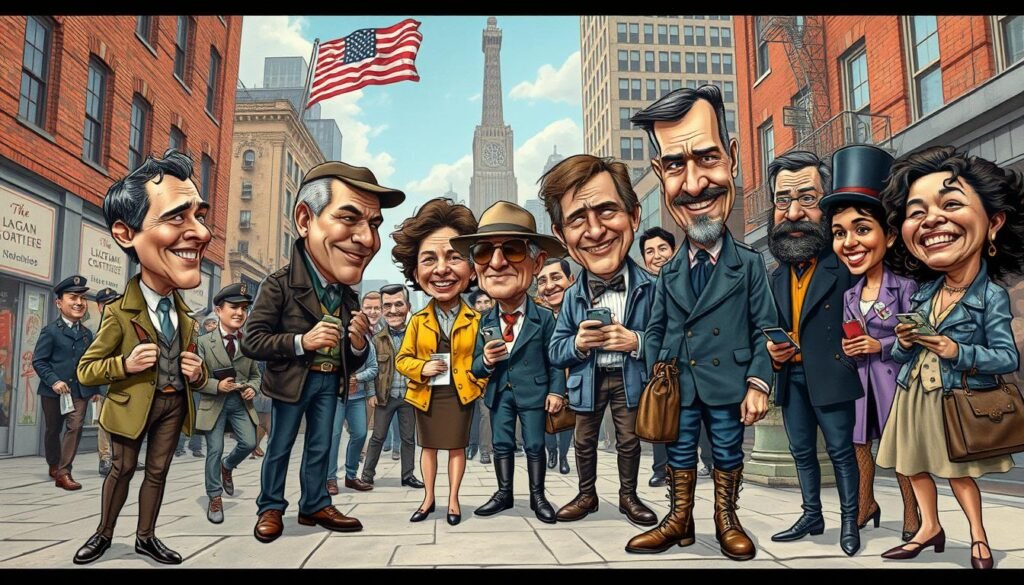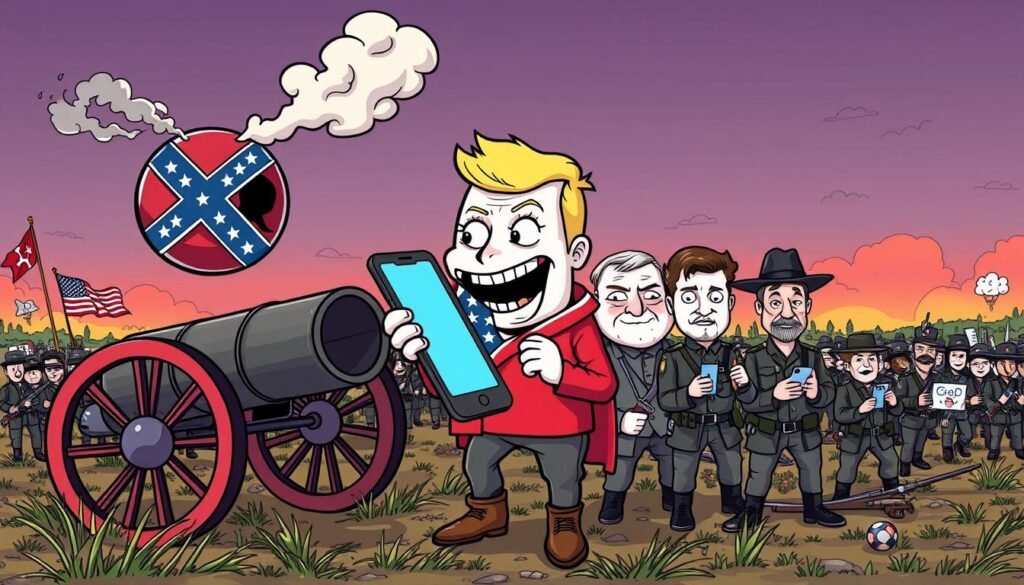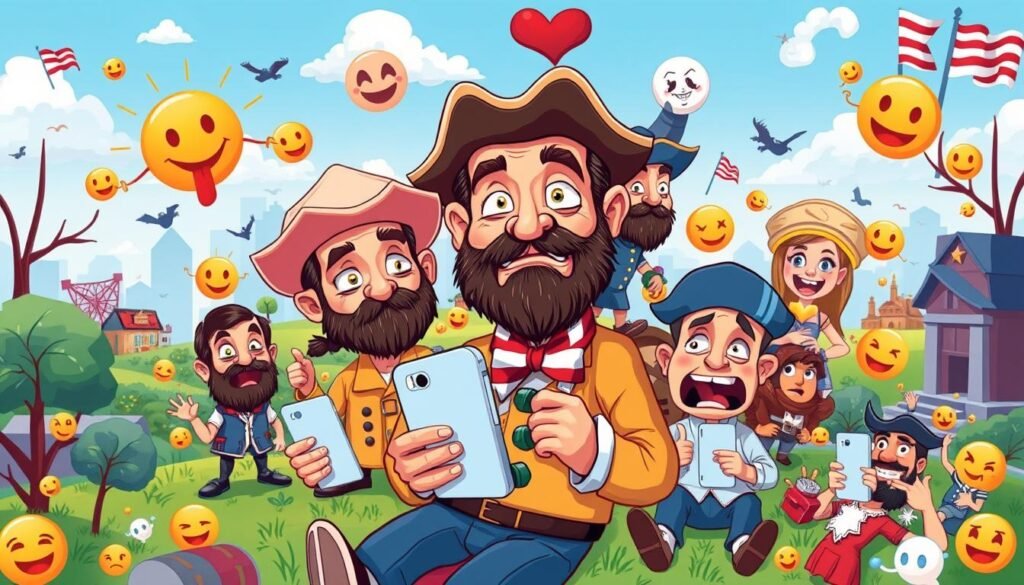Modern-Day Memes Inspired by Civil War Cartoons
The images from the Civil War era look a lot like today’s memes. This shows that humor and satire in social commentary never fade. It proves that memes from history have turned into the memes we see online today.
The idea that today’s memes come from Civil War cartoons is really interesting. It shows how satire and humor in social commentary have changed over time. Both historical cartoons and today’s memes use humor to make points about society.
Key Takeaways
- Modern-day memes have historical roots in Civil War-era cartoons, showing how satire and humor in social commentary have evolved.
- Historical memes, like Civil War cartoons, were used to share humor and social commentary, just like today’s memes.
- The use of satire and humor in social commentary has been a constant theme, from Civil War cartoons to modern memes.
- Internet humor, including today’s memes, has been shaped by historical memes and satire, showing their lasting impact.
- Studying historical memes and internet humor can give us insights into the evolution of social commentary and satire.
The Evolution of Political Cartoons to Modern-Day Memes
Political cartoons have been around for over 200 years. They have played a big role in showing major debates in U.S. history. Now, these cartoons have evolved into modern civil war jokes. These jokes are shared widely as viral meme content on social media.
Satire has always been a key part of political cartoons. They use humor and irony to talk about current events and big issues. Today, memes do the same thing, making social commentary through viral content.
Understanding the History of Political Cartoons
Political cartoons started in the early 18th century. They were used to share opinions and sway public opinion. The “Join or Die” cartoon is a great example. It was used to push for colonial unity against threats.
The Birth of Internet Meme Culture
The 2010s saw a big jump in internet memes as a way to express politics. This led to the rise of viral meme content. Now, people use these memes to share jokes and make social commentary on social media.
| Year | Event | Impact on Political Cartoons |
|---|---|---|
| 1754-63 | French and Indian War | Influenced the creation of early political cartoons, which focused on unity |
| 1763 | Taxes on basic goods levied by Britain | Caused a lot of opposition among American colonists, showing strong dissent |
| 2010s | Rise of internet memes as a form of political expression | Resulted in the creation of viral meme content and modern civil war jokes on social media |
Famous Civil War Cartoons That Could Be Today’s Viral Memes
Historical memes are big in internet humor today. Many fans of meme culture look to the past for inspiration. The Civil War era had cartoons that could be today’s viral hits.
Thomas Nast’s cartoons were key in shaping American political art. His Santa Claus drawings in Harper’s Weekly from 1863 to 1886 are like early memes. His use of satire and social commentary is just as relevant today.
Nast’s work, like “Christmas, 1863” and “Christmas Eve, 1862,” used humor to tackle big issues. These could easily fit into today’s meme culture, using humor to share messages.
The humor and themes in these old cartoons are just as relatable today. They show how historical cartoons have influenced internet humor. By looking at these memes, we can see how humor has evolved over time.
How Modern-Day Memes Draw Inspiration from Civil War Cartoons
Modern memes often take inspiration from the American Civil War. Social media jokes and humorous historical references are key in today’s meme culture. They use satire and irony to offer social commentary in a fun and thought-provoking way.
Memes have changed from print to digital, reaching more people faster. Contemporary meme culture is all about adapting and evolving. It includes current events and trends in its humor, like commenting on racial injustice and public health.
Memes are great at telling stories through visuals. They use images, videos, and more to share complex ideas and feelings. Here’s how memes use visual storytelling:
| Technique | Description |
|---|---|
| Image macros | Using images with overlaid text to convey a message or tell a story |
| Videos | Using video clips to convey a message or tell a story |
| Memetic characters | Using recurring characters or symbols to convey a message or tell a story |
Memes today draw from history, like the Civil War, to talk about now. This shows memes’ power in social commentary and their ability to grow and change.
The Role of Symbolism: Then and Now
Symbolism has long been a key way to share complex ideas and beliefs. Internet humor often uses symbols and satire to comment on today’s events. For instance, the Republican elephant and the Democratic donkey, created by Thomas Nast, are symbols in American politics even today.
These symbols have appeared in historical memes to talk about political parties and their beliefs. Modern civil war jokes also use symbols to discuss issues like racism and social justice. Symbols in internet humor are a powerful way to share complex ideas, making them a strong tool for social commentary.
In internet humor, symbols help create funny yet thought-provoking comments on current events. By using symbols and satire, modern civil war jokes offer a fresh view on historical events and their connection to today’s issues. The use of symbols in memes and jokes shows how symbols can convey complex ideas and beliefs.
Viral Trends That Mirror Historical Political Messages
Today’s meme culture is filled with content that echoes old political messages. Social media jokes and memes are big in politics, letting people share their views on current issues.
More people are using social media now, with 72% of U.S. adults online in 2019, up from 43% in 2010. This growth has made memes a fast way to share opinions on politics and social issues.
Examples like the “I’m not a witch” ad and the “Deal With It Obama” meme show how memes reflect historical political cartoons. They use humor to talk about politics and social problems, just like cartoons did before.
The following table highlights the comparison between historical political cartoons and modern memes:
| Historical Political Cartoons | Modern Memes |
|---|---|
| Used satire and humor to comment on political issues | Use satire and humor to comment on political issues and social problems |
| Were often published in newspapers and magazines | Are shared on social media platforms |
| Were used to critique political figures and policies | Are used to critique political figures and policies |
The Psychology Behind Historical and Contemporary Visual Humor
Historical memes and internet humor play a big role in how we talk to each other today. Social media jokes and memes can change what we think and how we see the world. Studies show that humor and satire can deeply affect us and society.
A study looked at memes and found over 119 examples. It showed how important memes are in today’s humor. Richard Dawkins first talked about memes in 1976. Now, internet humor and social media jokes are key parts of our culture.
Historical memes and internet humor have changed how we share and connect. Millennials are using social media jokes and memes more than ever. This marks a new time for how we talk and share culture. Here’s a table showing how social media has grown and changed humor:
| Year | Social Media Platform | Users |
|---|---|---|
| 1997 | SixDegrees | 3.5 million |
| 2004 | 1 million | |
| 2010 | 1 million |
The rise of social media jokes and historical memes has changed how we enjoy humor. As we move forward, it’s key to grasp the psychological and cultural sides of these shifts.
Digital Transformation of Civil War Era Jokes
Historical content is now a big part of today’s memes. Modern civil war jokes are updated for today’s viewers. They use viral memes to share humor and social commentary.
This change lets more people enjoy historical jokes and satire. It also gives them new meanings in today’s world. Contemporary meme culture helps mix old and new comedy styles.
Here are some examples of this change:
- Using historical figures in memes to talk about today’s news
- Updating old jokes and satire for today’s social issues
- Making new comedy that mixes old and new elements
This digital shift changes how we see historical humor. It shows how jokes have always been a way to comment on society. By updating old jokes for today’s memes, we learn more about humor’s role in history.
| Historical Joke | Modern Meme | Contemporary Issue |
|---|---|---|
| Civil War-era cartoon | Modern meme using similar imagery | Commentary on contemporary social issue |
Social Media’s Role in Reviving Historical Humor
Social media has become a big place for bringing back old jokes and funny references. Social media jokes and humorous historical references are shared a lot. This is linked to the growth of contemporary meme culture, which often uses old events and people for laughs.
On social media, humorous historical references are used to talk about today’s issues. For instance, memes about old figures or events are used to make fun of today’s problems. This makes social media jokes a favorite way to comment.
Several things help bring back historical humor on social media, including:
- Platform-specific adaptations, like hashtags and memes on Twitter and Instagram
- Viral spread patterns, which let funny content spread fast to many people
- The ease of sharing and engaging with content, making it simple for users to join in on contemporary meme culture
As social media keeps changing, it will be exciting to see how social media jokes and humorous historical references keep shaping our view of history and current events.
| Platform | Features | Impact on Historical Humor |
|---|---|---|
| Hashtags, memes | Allows for quick dissemination of humorous content | |
| Visual-centric, hashtags | Facilitates the creation and sharing of visually-oriented memes | |
| Sharing, commenting | Enables users to engage with and share humorous content easily |
The Impact of Meme Culture on Historical Understanding
Studying historical memes and their changes can show us what people valued and thought in the past. Internet humor is big online today, with modern civil war jokes being a big part. Looking at how memes and history meet helps us understand how we see past events and people.
Some important things about meme culture’s effect on history include:
- Memes can show and change how we see history and its figures.
- Memes can be a way to teach and make people aware of history.
- Internet humor shapes how we talk and think about things.
Historical memes and modern civil war jokes can start important talks about tough subjects like racism and justice. By looking at how memes and history mix, we learn more about the complex ways we talk and think about things.
Creating Modern Memes from Historical Sources
Creating memes from history needs careful thought about the original content’s context and importance. Viral meme content can grab people’s attention and share big ideas in a fun, easy way. By using social media jokes and contemporary meme culture, we can make old sources fresh and reach more people.
To make great memes from history, follow these tips:
- Know the history and why it matters
- Use humor and irony to show how it’s relevant today
- Make the meme short and eye-catching
By sticking to these tips and thinking about the impact of social media jokes on contemporary meme culture, you can make memes that are fun, educational, and informative.
| Historical Source | Modern Meme | Contemporary Relevance |
|---|---|---|
| Benjamin Franklin’s “Join or Die” cartoon | A meme featuring a snake with a modern twist, such as a smartphone or a coffee cup | Commentary on the importance of unity and cooperation in modern society |
Future Trends in Historical Meme Evolution
The world of historical memes is always changing, with new trends popping up every day. As internet humor shapes how we see history, it’s key to think about what’s coming next. One trend could be using modern civil war jokes to talk about today’s news.
Here are some possible future trends in historical meme evolution:
- The use of artificial intelligence to generate historical memes
- The incorporation of virtual reality technology to create immersive historical experiences
- The rise of “alt-history” memes, which explore alternative scenarios and outcomes
Looking ahead, historical memes will keep shaping our view of history and its connection to today. By keeping up with trends, we can grasp the complex world of internet humor and its role in our culture.
The table below outlines some key trends and predictions for historical meme evolution’s future:
| Trend | Prediction |
|---|---|
| Artificial intelligence-generated memes | Increased use in the next 5 years |
| Virtual reality historical experiences | Growing popularity in the next 10 years |
| Alt-history memes | Rise in popularity as a niche genre |
Conclusion: The Timeless Nature of Visual Social Commentary
The link between today’s meme culture and historical jokes is clear. From Civil War cartoons to today’s memes, visual stories shape our talks. This power has always been there, connecting us through time.
Artists and satirists have long used humor to speak out. They’ve challenged norms and pushed for change. From James Gillray’s sharp critiques to “South Park’s” bold jokes, visuals have always sparked important talks.
Today, digital platforms and easy content creation have made this tradition even stronger. Memes now spread fast, reaching many people. They show us that using humor for change is just as important now as it was long ago.
FAQ
What is the connection between modern-day memes and historical Civil War cartoons?
How have political cartoons from the Civil War era evolved into today’s internet meme culture?
What are some examples of Civil War-era cartoons that could be adapted into viral memes today?
In what ways do modern memes draw inspiration from the visual techniques and humor styles of Civil War cartoons?
How have symbols been used in both historical cartoons and modern memes to convey complex ideas and ideologies?
What are some examples of viral meme trends that mirror historical political messages?
What psychological factors contribute to the resonance of visual humor in both historical cartoons and modern memes?
How have jokes and satire from the Civil War era been digitally transformed and reinterpreted in modern memes?
What role has social media played in reviving and spreading historical humor through memes?
How has meme culture impacted our understanding and perception of historical events and figures?
What are the best practices and ethical considerations for creating modern memes from historical sources?
What future trends can we expect in the evolution of historical memes?
Source Links
- 4 fascinating examples of Civil War humor
- Political Illustrations – Cartoon America | Exhibitions
- Political Cartoons and Public Debates | Classroom Materials at the Library of Congress | Library of Congress
- Microsoft Word – 177_Idris Young
- How Civil War Cartoonist Thomas Nast Created Our Image of Santa Claus and Turned Santa into a Full-Fledged Union Supporter – Emerging Civil War
- ‘Boris was cartoon gold’: the UK’s top cartoonists on drawing Boris Johnson
- How Benjamin Franklin’s Viral Political Cartoon United the 13 Colonies | HISTORY
- The History of Humor in Political and Social Movements: From Satirical Plays to Memes
- The Karen Genre: Digital Memes as an Influencer of Political and Social Discourse
- 101 political memes, art, and visual rhetoric that defined the 2010s
- Re: the meme to political cartoon pipeline
- ICONOGRAPHIC ANALYSIS ON FEMI FANI-KAYODE’S VISUAL GENRE OF CARTOONS AND POLITICAL COMMUNICATION
- Enter the Memescape: Memetic Imagery and Contemporary Art History
- A Brief History of Internet Culture and How Everything Became Absurd
- MIT Press Essential Knowledge : Memes in Digital Culture
- Comedy in Combat Culture
- Cartoons and Cartoonists – Page 9
- Viral Culture, Memes in Society and Politics: An Interview with Anastasia Denisova
- Microsoft Word – Urban Legends Thesis V3.docx
- The Historical Society, Boston University
- Cartoons and Social Commentary: A Powerful Duo in Popular Culture
- Conservative Right-Wing Protest Rhetoric in the Cold War Era of Segregationist Mobilization
























